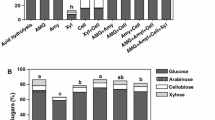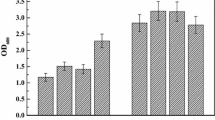Abstract
A large amount of wastewater containing various organic compounds is generated in the paper-making industry. Therefore, the re-utilization of wastewater from paper-making is of great importance. In this study, acetic acid and formic acid, the dominant inhibitors existing in the paper mill wastewater, were used to produce succinate by metabolically engineered Escherichia coli strains, HB04(pTrc99a-gltA) and HB04(pTrc99a-gltA, pBAD33-Trc-fdh). The distilled paper mill wastewater could be utilized and transformed directly to succinate efficiently. However, the utilization of acetate was inhibited dramatically using raw paper mill wastewater. After adsorption by activate carbon, the acetate consumption and succinate production were improved significantly. In the resting cells experiment with high cell density (50 OD600), acetate was consumed completely and the titer of succinate reached 65.44 mM in 6 h. These results showed that the metabolically engineered E. coli strains had great potential to utilize acetic acid in the paper mill wastewater for succinate biosynthesis.







Similar content being viewed by others
References
Thompson, G., Swain, J., Kay, M., & Forster, C. F. (2001). The treatment of pulp and paper mill effluent: a review. Bioresource Technology., 77(3), 275–286.
Kamali, M., & Khodaparast, Z. (2015). Review on recent developments on pulp and paper mill wastewater treatment. Ecotoxicology and Environmental Safety., 114, 326–342.
Jiang, Y., Marang, L., Tamis, J., Loosdrecht, M. C. M. V., Dijkman, H., & Kleerebezem, R. (2012). Waste to resource: converting paper mill wastewater to bioplastic. Water Research., 46(17), 5517–5530.
Sobral, O., Ribeiro, R., Goncalves, F., & Soares, A. M. V. M. (1998). Ecotoxicity of pulp mill effluents from different prebleaching processes. Bulletin of Environmental Contamination and Toxicology., 61(6), 738–745.
El-Bestawy, E., El-Sokkary, I., Hussein, H., & Keela, A. F. (2008). Pollution control in pulp and paper industrial effluents using integrated chemical-biological treatment sequences. Journal of Industrial Microbiology & Biotechnology., 35(11), 1517–1529.
Malaviya, P., & Rathore, V. S. (2007). Bioremediation of pulp and paper mill effluent by a novel fungal consortium isolated from polluted soil. Bioresource Technology., 98(18), 3647–3651.
Tarlan, E., Yetis, U., & Dilek, F. B. (2002). Algal treatment of pulp and paper industry wastewaters in SBR systems. Water Science and Technology., 45(12), 151–158.
Orrego, R., Guchardi, J., Krause, R., & Holdway, D. (2010). Estrogenic and anti-estrogenic effects of wood extractives present in pulp and paper mill effluents on rainbow trout. Aquatic Toxicology., 99(2), 160–167.
Zhang, H., Zhang, J., & Bao, J. (2016). High titer gluconic acid fermentation by Aspergillus niger from dry dilute acid pretreated corn stover without detoxification. Bioresource Technology., 203, 211–219.
Xiao, Y., Ruan, Z., Liu, Z., Wu, S. G., Varman, A. M., Liu, Y., & Tang, Y. J. (2013). Engineering Escherichia coli to convert acetic acid to free fatty acids. Biochemical Engineering Journal., 76, 60–69.
Hu, P., Chakraborty, S., Kumar, A., Woolston, B., Liu, H., Emerson, D., & Stephanopoulos, G. (2016). Integrated bioprocess for conversion of gaseous substrates to liquids. Proceedings of the National Academy of Sciences of the United States of America., 113(14), 3773–3778.
Yang, J. M., & Nie, Q. J. (2016). Engineering Escherichia coli to convert acetic acid to β-caryophyllene. Microbial Cell Factories., 15(1), 74.
Li, Y. J., Huang, B., Wu, H., Li, Z. M., Ye, Q., & Zhang, Y. P. (2016). Production of succinate from acetate by metabolically engineered Escherichia coli. ACS Synthetic Biology, 5(11), 1299–1307.
Huang, B., Yang, H., Fang, G. C., Zhang, X., Wu, H., Li, Z. M., & Qin, Y. (2018). Central pathway engineering for enhanced succinate biosynthesis from acetate in Escherichia coli. Biotechnology and Bioengineering., 115(4), 943–954.
Noh, M. H., Lim, H. G., Woo, S. H., Song, J., & Jung, G. Y. (2018). Production of itaconic acid from acetate by engineering acid-tolerant Escherichia coli W. Biotechnology and Bioengineering., 115(3), 729–738.
Lee, J. H., Cha, S., Kang, C. W., Lee, G. M., Lim, H. G., & Jung, G. Y. (2018). Efficient conversion of acetate to 3-hydroxypropionic acid by engineered Escherichia coli. Catalysts., 8(11), 525.
Jo, M., Noh, M. H., Lim, H. G., Kang, C. W., & Jung, G. Y. (2019). Precise tuning of the glyoxylate cycle in Escherichia coli for efficient tyrosine production from acetate. Microbial Cell Factories., 18(1), 57.
Balzer, G. J., Thakker, C., Bennett, G. N., & San, K. Y. (2013). Metabolic engineering of Escherichia coli to minimize byproduct formate and improving succinate productivity through increasing NADH availability by heterologous expression of NAD+-dependent formate dehydrogenase. Metabolic Engineering, 20(5), 1–8.
Ferguson, S. J. (2010). ATP synthase: from sequence to ring size to the p/o ratio. Proceedings of the National Academy of Sciences of the United States of America., 107(39), 16755–16756.
Zhu, L. W., Li, X. H., Zhang, L., Li, H. M., Liu, J. H., Yuan, Z. P., Chen, T., & Tang, Y. J. (2013). Activation of glyoxylate pathway without the activation of its related gene in succinate-producing engineered Escherichia coli. Metabolic Engineering., 20(5), 9–19.
Choi, S., Song, H., Lim, S. W., Kim, T. Y., Ahn, J. H., Lee, J. W., Lee, M. H., & Lee, S. Y. (2016). Highly selective production of succinic acid by metabolically engineered Mannheimia succiniciproducens and its efficient purification. Biotechnology and Bioengineering., 113(10), 2168–2177.
Lee, P. C., Lee, S. Y., & Chang, H. N. (2008). Succinic acid production by Anaerobiospirillum succiniciproducens ATCC 29305 growing on galactose, galactose/glucose, and galactose/lactose. Journal of Microbiology and Biotechnology., 18(11), 1792–1796.
Li, Q., Wu, H., Li, Z. M., & Ye, Q. (2016). Enhanced succinate production from glycerol by engineered Escherichia coli strains. Bioresource Technology., 218, 217–223.
Soboh, B., Pinske, C., Kuhns, M., Waclawek, M., Ihling, C., Trchounian, K., Trchounian, A., Sinz, A., & Sawers, G. (2011). The respiratory molybdo-selenoprotein formate dehydrogenases of Escherichia coli, have hydrogen: benzyl viologen oxidoreductase activity. BMC Microbiology., 11(1), 173.
Ma, S. M., Garcia, D. E., Redding-Johanson, A. M., Friedland, G. D., Chan, R., Batth, T. S., Haliburton, J. R., Chivian, D., Keasling, J. D., Petzold, C. J., Lee, T. S., & Chhabra, S. R. (2011). Optimization of a heterologous mevalonate pathway through the use of variant HMG-CoA reductases. Metabolic Engineering., 13(5), 588–597.
Dabrowski, A., Podkościelny, P., Hubicki, Z., & Barczak, M. (2005). Adsorption of phenolic compounds by activated carbon--a critical review. Chemosphere., 58(8), 1049–1070.
Unrean, P. (2016). Bioprocess modelling for the design and optimization of lignocellulosic biomass fermentation. Bioresources and Bioprocessing., 3(1), 1–9.
Bhatnagar, A., Hogland, W., Marques, M., & Sillanpää, M. (2013). An overview of the modification methods of activated carbon for its water treatment applications. Chemical Engineering Journal., 219(3), 499–511.
Gupta, V. K., Carrott, P. J. M., Carrott, M. M. L. R., & Suhas. (2009). Low-cost adsorbents: growing approach to wastewater treatment - a review. Critical Reviews in Environmental Science and Technology., 39(10), 783–842.
Haroun, B. M., Nakhla, G., Hafez, H., & Nasr, F. A. (2016). Impact of furfural on biohydrogen production from glucose and xylose in continuous-flow systems. Renewable Energy., 93, 302–311.
Miller, E. N., Jarboe, L. R., Yomano, L. P., York, S. W., Shanmugam, K. T., & Ingram, L. O. (2009). Silencing of NADPH-dependent oxidoreductase genes (yqhD and dkgA) in furfural-resistant ethanologenic Escherichia coli. Applied and Environmental Microbiology., 75(13), 4315–4323.
Wang, X., Yomano, P., Lee, J. Y., York, S. W., Zheng, H., Mullinnix, M. T., & Ingram, L. O. (2013). Engineering furfural tolerance in Escherichia coli improves the fermentation of lignocellulosic sugars into renewable chemicals. Proceedings of the National Academy of Sciences of the United States of America., 110(10), 4021–4026.
Weil, J. R., Dien, B., Bothast, R., Hendrickson, R., Mosier, N. S., & Ladisch, M. R. (2002). Removal of fermentation inhibitors formed during pretreatment of biomass by polymeric adsorbents. Industrial & Engineering Chemistry Research., 41(24), 6132–6138.
Anbia, M., & Mohammadi, N. (2009). A nanoporous adsorbent for removal of furfural from aqueous solutions. Desalination., 249(1), 150–153.
Sundqvist, B., Karlsson, O., & Westermark, U. (2006). Determination of formic acid and acetic acid concentrations formed during hydrothermal treatment of birch wood and its relation to colour, strength and hardness. Wood Science and Technology., 40(7), 549–561.
Saha, B. C., Qureshi, N., Kennedy, G. J., & Cotta, M. A. (2015). Enhancement of xylose utilization from corn stover by a recombinant Escherichia coli strain for ethanol production. Bioresource Technology., 190, 182–188.
Jin, L. Q., Xu, W., Yang, B., Zhi, Q. L., & Zheng, Y. G. (2018). Efficient biosynthesis of xylitol from xylose by coexpression of xylose reductase and glucose dehydrogenase in Escherichia coli. Applied Biochemistry and Biotechnology., 187(4), 1143–1157. https://doi.org/10.1007/s12010-018-2878-0.
Liu, R., Liang, L., Cao, W., Wu, M., Chen, K., Ma, J., Jiang, M., Wei, P., & Ouyang, P. (2013). Succinate production by metabolically engineered Escherichia coli using sugarcane bagasse hydrolysate as the carbon source. Bioresource Technology., 135, 574–577.
Mao, Y. F., Li, G. Y., Chang, Z. S., Tao, R., Cui, Z. Z., Wang, Z. W., Tang, Y. J., Chen, T., & Zhao, X. M. (2018). Metabolic engineering of Corynebacterium glutamicum for efficient production of succinate from lignocellulosic hydrolysate. Biotechnology for Biofuels., 11(1), 95.
Takahashi, C. M., Takahashi, D. F., Carvalhal, M. L., & Alterthum, F. (1999). Effects of acetate on the growth and fermentation performance of Escherichia coli KO11. Applied Biochemistry and Biotechnology., 81(3), 193–203.
Funding
This study was supported by the National Natural Science Foundation of China (Grant No. 21776083), the National High Technology Research and Development Program of China (No. 2011AA02A203), and the Fundamental Research Funds for the Central Universities (22221818014). This project was also supported by the Key Laboratory of Systems Microbial Biotechnology, Tianjin Institute of Industrial Biotechnology, Chinese Academy of Sciences.
Author information
Authors and Affiliations
Corresponding author
Ethics declarations
Conflict of interest
The authors declare that they have no competing interests.
Additional information
Publisher’s Note
Springer Nature remains neutral with regard to jurisdictional claims in published maps and institutional affiliations.
Rights and permissions
About this article
Cite this article
Huang, B., Fang, G., Wu, H. et al. Efficient Biosynthesis of Succinate from Paper Mill Wastewater by Engineered Escherichia coli. Appl Biochem Biotechnol 189, 1195–1208 (2019). https://doi.org/10.1007/s12010-019-03066-2
Received:
Accepted:
Published:
Issue Date:
DOI: https://doi.org/10.1007/s12010-019-03066-2




